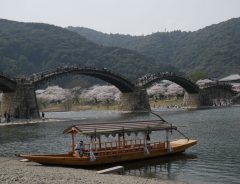- Tags:
- Bridge / cormorant fishing / Iwakuni / Iwakuni-zushi / Kintaikyō Bridge / Ukai / Yamaguchi Prefecture
Related Article
-

A Memorable Excursion to Idyllic Takataki Lake – Part 2: Scenic Walk, Museum and Shrine
-

Step into A Japanese Fairy-tale: The Inaho Fox Wedding
-

These Tourists Were Crossing The Bridge, Then The Bridge Fails…
-

Illegal motorbike crossing leaves Iwakuni’s Kintaikyo bridge beaten and battered
-

Ukai: A Tokyo Restaurant Rich With Beautiful Gardens And Traditional Seasonal Cuisine
-

Toei Kyoto Studio Park: Experience The Thrilling World of Japanese Hollywood (Part 2)



Straddling the river of the old castle town of Iwakuni, like a pebble skipping across the water, the five arches of Kintaikyō bridge (錦帯橋) form a sight similar to traditional Ukiyo-e Japanese art prints.
Classified as one of Japan’s top 3 bridges, the bridge is not to be missed when exploring the area of western Honshu. About an hour away from Hiroshima, the bridge makes for a great half-day trip and is an excellent entrance into the rural and historical world of Yamaguchi Prefecture.
History of the Bridge
Following the completion of Iwakuni Castle in 1608, a sequence of wooden bridges were constructed across the Nishiki River. Numerous floods washed away or damaged bridges in turn and the construction of a more durable bridge was ordered by the third daimyo of Iwakuni, Kikkawa Hiroyoshi in 1673.
The first construction, thought to be flood-proof was washed away during a flood in the rainy season of 1674. However, the second attempt involved replacing the wooden piers with stone designed for greater strength and introduced a bridge tax for maintaining the structure, which allowed the bridge to stand for 276 years until it was swept away by the typhoon Kijia in 1950.
The bridge was in a state of disrepair at the time as maintenance had ceased during World War II, and had yet to resume following the war exhaustion. The structure standing today was completed in 1953 and was reconstructed by the efforts of determined residents of the Iwakuni area.
Historically, during the feudal era, the bridge was only allowed to be crossed by members of the upper class who could cross between the samurai quarters on the western bank of the river and the rest of Iwakuni town on the east.
The famous Kintaikyō bridge spans 175 meters across the wide river and is made up of five wooden arch bridges standing atop of four stone piers in the water and two wooden piers on the dry riverbed on both sides.
Although the current structure at Nishiki River makes use of metal nails made from tatara iron (the same iron used for making katana swords) to increase the strength, the original construction which stood for almost 300 years stood without the use of nails. This traditional architecture technique involved the fitting of the wooden parts using careful clamping and binding as well as mortise and tenon joints and can still be seen used today in some of Japan’s wooden temples and shrine buildings.
The careful fitting of the wood and the mortise and tenon joints were used so that in the case of a flood, the bridge would not be completely destroyed, but instead, the wooden pathway would be lifted from its frame and would leave the main structure of the bridge standing.
During the early 2000s, renovation works were performed on the bridge for the first time since its reconstruction and cost nearly 2.5 billion yen, a sum which is still being paid through the small fee which is needed to cross the bridge by foot.
On the far side of the bridge you can try the local food, Iwakuni-Zushi | Photo by Connie Sceaphierde
Beyond the Bridge
On the western bank of the Nishiki River is the Kikko Park, which contains the remains of the old samurai quarters of Iwakuni. Set at the foot of Mount Yokoyama, the park is home to old residences, ancient halls, a number of museums and restaurants selling the local specialty Iwakuni-zushi. There are also two rival ice cream shops within the park selling over 100 flavours of ice cream including bizarre flavours such as wasabi or octopus. These ice cream shops are particularly popular during the summer, with queues spreading out across the park.
A small zoo-like building dedicated to white snakes stands just beyond the park, where several of the famous albino snakes unique to Iwakuni are on display. These non-poisonous snakes are found nowhere else in Japan and have been believed to protect the surrounding rural areas from famine as they feed on mice and rats.
A cable car station next to the white snake museum links the foot of Mount Yokoyama to Iwakuni Castle which sits on top, overlooking the city. The cable car costs 320 yen for a single or 550 yen for a return, or alternatively the castle can be reached by foot in 45 minutes on a pathway which leads up from the west side of the park. Entrance to the castle costs 260 yen and is open daily between 9 am and 4:45 pm.
Watch cormorant fishing Events on the river
During the summer period between June 1st and August 31st, traditional cormorant fishing, known as ukai 鵜飼 in Japanese, takes place on the Nishiki River and can be seen next to the bridge between 6:30 pm and 9 pm. It is free to watch this odd tradition of fishing with birds from the riverbank.
Kintaikyō can be on the bridge itself, from a distance or even by boat. | Photo by Connie Sceaphierde
How to get to Kintaikyō
Iwakuni Kintaikyō bridge can be reached by bus in 10 minutes from Shin-Iwakuni Shinkansen station which costs 280 yen or in 15 minutes from the JR Iwakuni station, costing 240 yen.